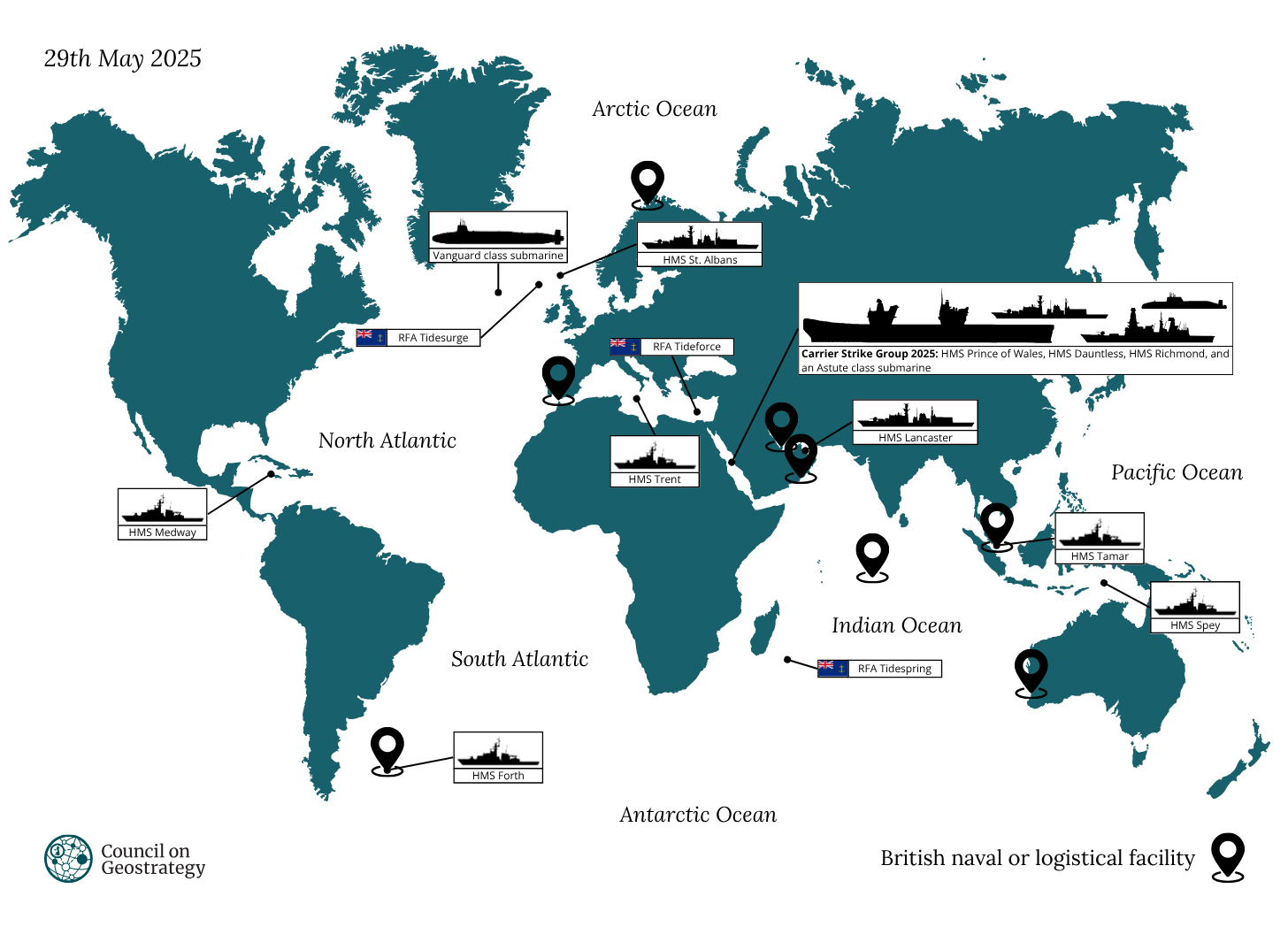North Korea’s horizontal frigate
The Signal | No. 06.2025
Welcome to The Signal, your monthly maritime newsletter, written and edited by Dr Emma Salisbury.
You will have noticed that The Signal has a new home – The Broadside, your source for the best maritime writing and analysis from the Sea Power Laboratory at the Council on Geostrategy. I am personally honoured to be Editor of this exciting project – if you have some maritime thoughts which you’d like to write about, please do take a look at our submission guidelines and pitch me!
Thoughts from your correspondent
Those of a ship-centric persuasion will likely have seen that North Korea’s newest ship appears to have, er, fallen over. The frigate apparently became stuck while side-launching after the stern transport cradle slid off, leaving it lying awkwardly on a slipway at Hambuk Shipyard in Chongjin with probable damage to the hull. Satellite imagery shows that it has been covered in what looks to be a lot of blue tarps, which are doing a great job of completely hiding the fact that it has, in fact, fallen over.
As the regime’s news agency reported, ‘Respected Comrade Kim Jong Un made a stern assessment, saying that it was a serious accident and criminal act caused by sheer carelessness, irresponsibility and unscientific empiricism which should never occur and could not be tolerated.’ Worrying times for the personnel involved, given Kim’s record.
This unnamed ship is the second of its class, following the unveiling of the lead ship Choi Hyon only weeks ago. The Choi Hyon test-fired its array of 74 vertical launch system (VLS) cells shortly after its launch, with what looked to be various kinds of surface-to-air and cruise missiles.
Building these two frigates so quickly at different shipyards signals how important this programme is for the Kim regime, as these are the first ships it has built since the 1970s which can be reasonably classified as principal surface combatants. Kim inherited a navy mainly composed of littoral patrol vessels and small submarines, which would likely have been restricted to coastal defence in the event of a conflict, and he has committed to modernising his fleet with new frigates, corvettes and submarines to expand North Korea’s blue-water capabilities.
The need for such conventional blue-water capabilities is questionable – the power projection enabled by an ocean-going fleet is not something which the North Korean regime needs to pursue its own security on the Korean Peninsula. The country has never shown interest in adventuring much beyond its own backyard, so it would not have been surprising if Kim had chosen to retain his navy’s historic focus on coastal defence. What Kim does value, however, is prestige. The very fact of having and building frigates, even if one isn’t intending to send them very far, adds a veneer of military status (at least on paper) which is easy to imagine holds great appeal for the dictator.
What we are unsure of is whether these ships actually work as advertised. Is the technology homegrown or (more likely) sourced from Russia – and if the latter, does North Korea have the ability to use it properly? Were these frigates built so quickly because they are not fully complete under the hull? Gleaning accurate information from such a secretive regime is, as ever, extremely difficult – and it is in Kim’s interests to make his ships look more impressive than they are, given that they are primarily propaganda tools rather than weapons. Hopefully, there won’t be a conflict in which these ships are tested – so we may never know if the North Korean navy is powering ahead or, if you’ll pardon the pun, running out of Juche.
Tracking the deployments of the Royal Navy
Key movements:
Exercise Med Strike saw the British Carrier Strike Group led by HMS Prince of Wales team up with an Italian Carrier Strike Group led by ITS Cavour for a week-long exercise in the Mediterranean, alongside eight other North Atlantic Treaty Organisation (NATO) allies. The programme included F-35B Joint Combat Aircraft flying operations, Anti-Submarine Warfare (ASW) training and an Air Defence Exercise (ADEX), plus gunnery training for HMS Richmond and a replenishment at sea mission for HMS Dauntless and the Norwegian tanker HNoMS Maud.
HMS Tyne shadowed two Russian vessels transiting the English Channel. The first was the Krasnodar, a Kilo class attack submarine, which was travelling on the surface back to Russia from the eastern Mediterranean. Shortly afterwards, HMS Tyne tracked the Steregushchiy class corvette Boikiy as it headed westward from the Baltic Sea, through the Dover Strait, and back again.
Six Royal Navy P2000 Inshore Patrol Craft have arrived in the Baltic Sea for BALTOPs. HMS Archer, HMS Biter, HMS Dasher, HMS Example, HMS Pursuer and HMS Smiter are joining the six-week-long NATO exercise, as well as doing training and port visits. They will then put in to represent the Royal Navy at Kiel Week in June – where your correspondent will also be. If any of the crews would like to let me drive their ship around a bit, please do get in touch – I promise I’ll be really careful.
HMS Trent is back in action after a seven-month upgrade in Malta. Along with general maintenance and upgrades to her deck, radar and lighting, the offshore patrol vessel (OPV) received what I personally rate as the most important upgrade – a dazzle camouflage paint job to match her sister ships in the River class. After flying trials in UK waters, she’ll be off back to the Caribbean for hurricane season this summer.
HMS Middleton took part in a Safety Of Life At Sea (SOLAS) exercise in the Persian Gulf alongside the United States (US), Kuwait and Iraq. The minehunter had the role of overseeing the mock rescue: first to locate an aircraft which had been forced to land on the water, then to coordinate the response of the assorted vessels and aircraft.
HMS Glasgow, the first of the Royal Navy’s new Type 26 frigates, has been formally named by her Sponsor, HRH The Princess of Wales, with the breaking of a bottle of whisky over the hull. These frigates possess the cutting edge in ASW technologies, and will be a fantastic addition to the fleet.
Maritime news from allies and adversaries
United States (US): The first Constellation class frigate has been confirmed to be still only 10% complete over two years after construction began and five years after the contract was awarded…and the design isn’t even finalised yet either. I’ve already written about how ridiculous this programme has become, but I may need to update this with louder screams of frustration – the US Navy needs a frigate, and needs it now.
Russia: The Russian ‘shadow fleet’ is now being actively protected by the Kremlin. In an incident in Estonian waters, a Russian Su-35 fighter jet was sent to support an unflagged tanker intercepted by the Estonian military – a first, but likely not the last we’ll see of this kind of reaction.
People’s Republic of China (PRC): The shipyards have been busy once again – the Chinese Coast Guard looks to have a new design in the works for OPVs, and the People’s Liberation Army Navy (PLAN) seems to have taken delivery of a new Extra-Large Uncrewed Undersea Vehicle (XLUUV) which is probably armed, unlike ours.
France: The Marine Nationale is running POLARIS 25, a major high-intensity operational readiness exercise involving personnel and assets from across the French Armed Forces, as well as participation from eight allied and partner nations (including the UK).
Brazil: There has now been formal confirmation of the potential sale of HMS Albion and HMS Bulwark to Brazil. The two Landing Platform Docks (LPDs) are scheduled for decommissioning as part of British fleet restructuring, and Brazil is keen to acquire this kind of amphibious capability – the deal could be a win-win.
Japan: My authorial privilege means I get to lean into my bias towards ships I think are pretty, so join me in welcoming the commissioning of the JS Niyodo, Japan’s seventh Mogami class frigate and the first to be fitted with Mk 41 VLS.
Naval technology news
The new Disruptive Capabilities and Technologies Office (DCTO) will bring together the great minds of NavyX, the Office of the Chief Technology Officer and the Navy Artificial Intelligence (AI) Cell to provide a central driving force for innovation in the Royal Navy. Good bureaucratic organisation is not the sexiest part of military tech, but it is deeply important – many militaries struggle with it. There will also be a sea-going element, the Fleet Experimental Squadron, which leads me smoothly on to…
XV Excalibur has been formally named. The Royal Navy’s first XLUUV will act as a testbed for leading-edge maritime technology, shaping future concepts in partnership with the surface vessel XV Patrick Blackett in the new Fleet Experimentation Squadron. XLUUVs – essentially uncrewed submarines – bring stealth and surveillance capabilities, as well as being able to carry bespoke payloads.
HMS Dragon has successfully destroyed a supersonic missile target with a modified Sea Viper as part of Exercise Formidable Shield 25. The missile accelerated to Mach 4 and manoeuvred to destroy the sea-skimming target within seconds in a first for the Royal Navy – a great sign for the Type 45 destroyer’s air defence capabilities.
RNAS Culdrose is getting an upgrade to its training facilities. The package includes enhanced simulator suites from Lockheed Martin and upgrades to the King Air Avenger training aircraft, which act as ‘flying classrooms’ for the Fleet Air Arm.
Who deserves a mention
In a world first, Ukraine has used a naval drone to shoot down not one, but two Russian fighter jets. The Magura V7 uncrewed surface vessel used American-made Sidewinder missiles to hit the two Su-30 Flanker aircraft. This conflict is rewriting the rules of warfare in many ways, but this is a particularly noteworthy development. BZ to the Ukrainian Armed Forces, and Слава Україні!
‘My arm was strong enough, it is true, to stop with a single shock all the horses of the continent. But I could not bridle the English fleet and there lay all the mischief.’
– Napoleon Bonaparte in exile on St Helena, 1816.
A reading list on maritime matters
‘Virtual Warrior: Royal Navy training to fight modern threats before setting sail’ by Navy Lookout – a technical briefing on how the Royal Navy conducts virtual exercises.
‘Thinking Sailors: Re-imagining Staff Training and Postgraduate Education for the Royal Navy’ by Oliver de Silva in Wavell Room – a comprehensive vision of what Royal Navy education could look like.
‘Software-Defined Warships: The Navy’s Digital Future of Necessity’ by Artem Sherbinin and Austin Gray in War on the Rocks – how centring ship design on software rather than hardware can revolutionise the upgrading of platforms.
‘Mine Counter Measures: A Quest for True Autonomy’ by Edward Black for RUSI – a look at the use of autonomous systems in tackling mines.
Dr Emma Salisbury is the Editor of The Broadside, Sea Power Research Fellow at the Council on Geostrategy and Associate Fellow at the Royal Navy Strategic Studies Centre.
To stay up to date with The Broadside, please subscribe or pledge your support!
What do you think about this article? Why not leave a comment below?











“Running out of Juche” deserves recognition. Bravo.